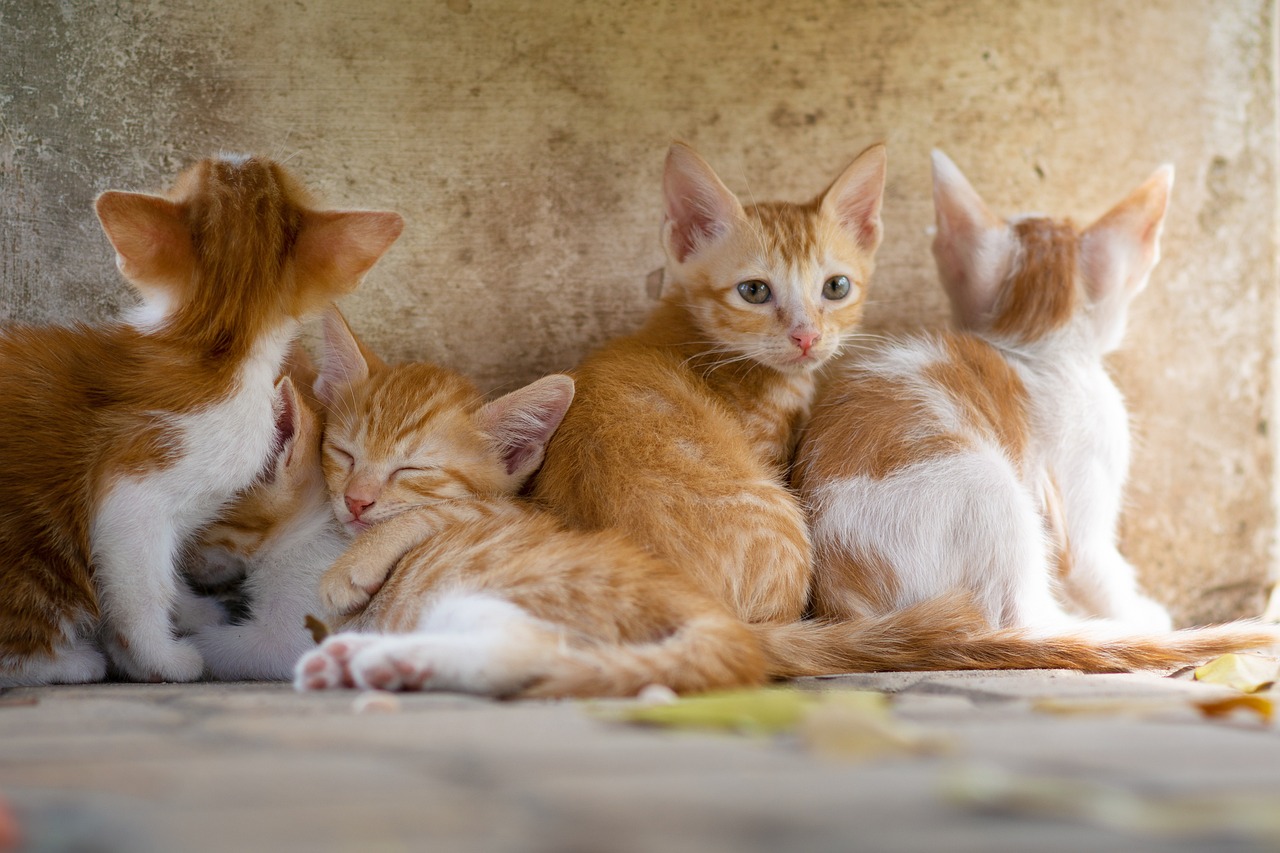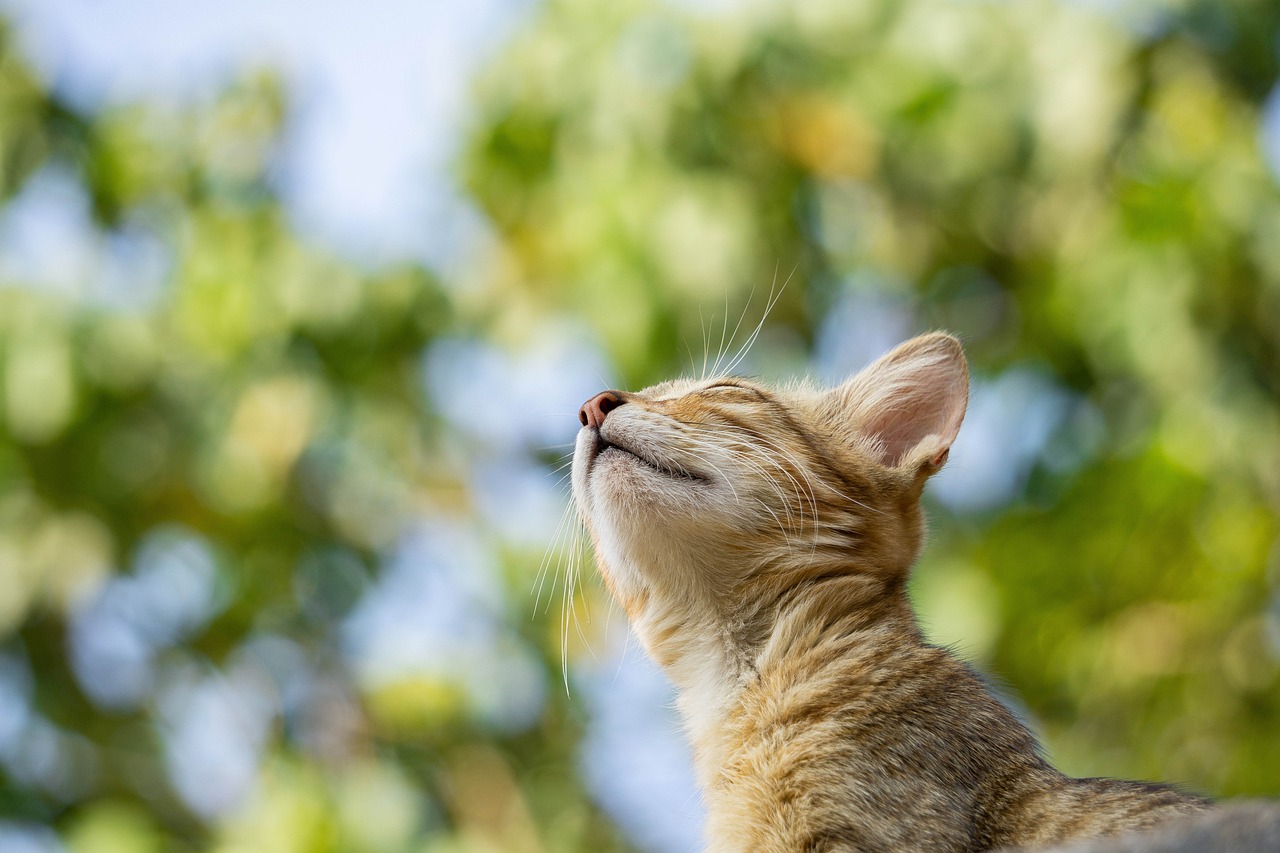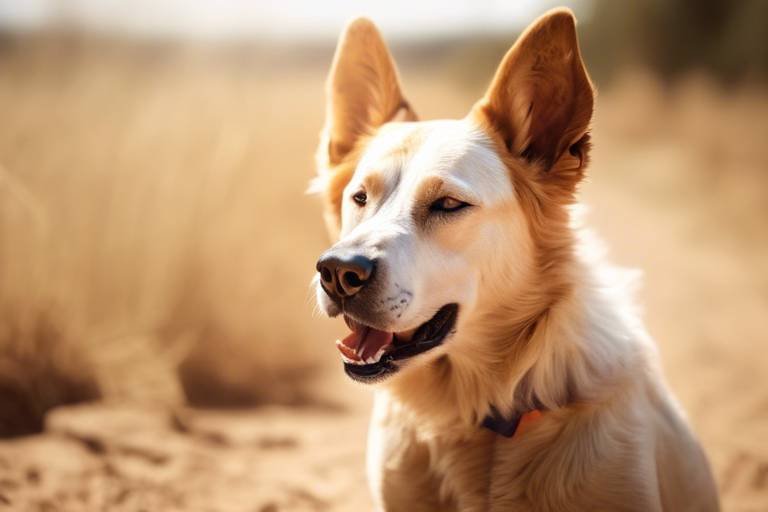The Benefits of a Multi-species Household for Pet Health
Have you ever thought about the magic that happens when different species of pets share a home? It’s not just about having a dog and a cat lounging together; it’s about creating a vibrant, dynamic environment that can enhance the health and happiness of both pets and their owners. In a world where we often seek connections and companionship, a multi-species household offers a unique opportunity to foster relationships that go beyond the usual. From improved socialization skills to diverse nutritional needs, the benefits are as varied as the pets themselves. So, let’s dive into the incredible advantages of having multiple species in your home!
Imagine a household where your dog learns to communicate with your cat, or your rabbit gets along with your parakeet. Having various species of pets can significantly enhance their socialization skills. When pets interact with different species, they learn to navigate social cues and develop better communication skills. This not only leads to healthier relationships among your furry (or feathered) friends but also reduces common behavioral issues often seen in single-species households. For example, dogs that grow up with cats often learn to be more gentle and patient, while cats that share space with dogs may become more confident and adventurous.
Every species has its own unique dietary requirements, and a multi-species household encourages pet owners to expand their knowledge about nutrition. This is not just about feeding; it’s about understanding the intricate balance of diets that can lead to better health and well-being for all pets involved. For instance, dogs require a protein-rich diet, while rabbits thrive on fiber. By learning about these diverse needs, owners can ensure that each pet receives balanced meals tailored to their specific requirements.
Incorporating pets with different diets helps owners appreciate the importance of variety in nutrition. Just like we enjoy a colorful plate of food, pets benefit from a range of nutrients. A well-rounded diet can prevent health issues and promote longevity, making it essential for pet owners to explore different food options. For example, while your cat might enjoy fish-flavored kibble, your dog could be munching on chicken-flavored treats. This variety not only keeps mealtime interesting but also ensures that each pet is getting what they need to thrive.
Moreover, owners can provide supplements and treats that cater to different species, enhancing overall nutrition. Think of it as a buffet for your pets! From vitamin-rich snacks for your dog to fresh greens for your rabbit, having multiple species in the household opens up a world of possibilities for enriching their diets. This not only boosts their health but also makes mealtime more engaging and enjoyable.
A multi-species environment naturally encourages active play among pets. When dogs chase cats or rabbits hop around, it promotes physical activity that can help prevent obesity. In today’s world, where sedentary lifestyles are common, this active interaction is crucial for maintaining a healthy weight and overall well-being for all animals in the household. Just like us, pets need exercise to stay fit, and what better way to motivate them than through playful interactions with their housemates?
Exposure to different species can provide significant behavioral enrichment. Pets learn from one another, engaging in diverse activities that stimulate their minds and bodies. This interaction can lead to improved problem-solving skills and creativity in play. For instance, a dog might learn new tricks from watching a cat, while a bird could inspire a rabbit to explore new heights. The possibilities are endless, and the benefits are profound!
Let’s face it: life can be stressful, and we all seek companionship to ease our worries. The presence of multiple species can significantly improve the mental health of both pets and their owners. Imagine coming home to a lively household where your dog, cat, and rabbit greet you with enthusiasm. This lively environment fosters companionship that can alleviate stress and improve overall emotional well-being for everyone in the household. It’s like having a built-in support system that brings joy and laughter into your life.
Having pets of different species creates a unique bond that can be incredibly rewarding. Each pet brings its own personality and quirks, making every day an adventure. This companionship can lead to reduced feelings of loneliness or anxiety, providing comfort during tough times. Just as we lean on friends and family for support, our pets can offer the same kind of emotional solace. It’s a beautiful cycle of love and care that enriches our lives.
Interactions between different species can also help reduce anxiety levels in pets. As they learn to adapt and coexist, they often exhibit calmer behaviors, creating a more harmonious home environment. For example, a shy dog may gain confidence by observing a bold cat, while an anxious rabbit might feel secure in the presence of a friendly dog. This mutual support system is invaluable in promoting a peaceful atmosphere where everyone feels safe and loved.
Lastly, a multi-species household promotes physical activity among pets. When they engage in play with one another, it leads to healthier, more active lifestyles. This is not just beneficial for their physical health; it also enhances their social skills and overall happiness. Just like how we feel rejuvenated after a good workout, pets thrive on the energy and excitement of playtime.
Different species often engage in various play styles, which can encourage exercise and stimulate mental engagement. For instance, while your dog may enjoy a game of fetch, your cat might prefer to chase a feather toy. This diversity in play not only keeps pets entertained but also encourages them to stay active and mentally sharp. It’s a wonderful way to ensure that every pet gets the exercise they need while having fun!
Having multiple species also encourages outdoor activities. Imagine taking your dog, cat, and rabbit on an adventure in the park! This not only allows pets to explore and experience nature together but also enhances their physical health and social skills. Outdoor time is essential for all pets, and sharing these moments can strengthen the bond between them and their owners.
- What are the benefits of having multiple species of pets?
Having multiple species can improve socialization, encourage active lifestyles, and enhance mental health for both pets and their owners.
- How can I ensure each pet's dietary needs are met?
Research the dietary requirements of each species and provide a balanced diet tailored to their specific needs.
- Can different species of pets get along?
Yes, with proper introductions and socialization, many species can coexist harmoniously.

Improved Socialization Skills
This article explores the advantages of having multiple species of pets in a household, including enhanced socialization, improved mental health, and diverse companionship benefits for both pets and their owners.
Having various species of pets can significantly enhance their socialization skills. Imagine a household where dogs, cats, rabbits, and even birds coexist; each animal brings its own unique personality and communication style to the mix. This diversity promotes better interaction among them, allowing pets to learn vital social cues from one another. For instance, a dog may learn to be more gentle from a cat, while a rabbit might pick up some playful behavior from a puppy. This cross-species interaction can lead to healthier relationships and reduces the behavioral issues often seen in single-species households.
In a multi-species environment, pets are constantly exposed to different sounds, movements, and behaviors that they might not encounter otherwise. This exposure helps them become more adaptable and less fearful of unfamiliar situations. As they navigate their interactions, they develop better communication skills, which can be particularly beneficial for pets that are naturally shy or anxious. The result? A more harmonious home where pets feel comfortable and confident.
Moreover, these improved socialization skills can also translate to better behavior in public settings. Pets that regularly interact with different species tend to be more well-rounded and less territorial. They learn to share space, which can be a crucial skill when visiting parks or attending pet-friendly events. In essence, the diverse social landscape of a multi-species household prepares pets for the outside world, making them more adaptable and less likely to engage in aggressive behaviors.
To summarize, a multi-species household can:
- Enhance communication skills among pets.
- Reduce behavioral issues through positive interactions.
- Foster adaptability and confidence in various environments.
- Prepare pets for social situations outside the home.
Ultimately, the beauty of a multi-species household lies in the rich tapestry of interactions that occur daily. Each pet contributes to a vibrant community, making the home a lively and engaging place for both pets and their owners.
Different species have unique dietary requirements. A multi-species household encourages owners to learn about various nutrition needs, ultimately fostering better health and well-being for all pets involved.
Incorporating pets with different diets helps owners appreciate the importance of variety in nutrition, ensuring that each pet receives balanced meals tailored to their specific needs.
Owners can provide supplements and treats that cater to different species, enhancing overall nutrition and health while also making mealtime more interesting for pets.
A multi-species environment encourages active play among pets, which can help prevent obesity and promote a healthier lifestyle for all animals in the household.
Exposure to different species can provide behavioral enrichment, allowing pets to learn from one another and engage in diverse activities that stimulate their minds and bodies.
The presence of multiple species can significantly improve the mental health of both pets and their owners, providing companionship and reducing feelings of loneliness or anxiety.
Having pets of different species creates a lively environment, fostering companionship that can alleviate stress and improve overall emotional well-being for everyone in the household.
Interactions between different species can reduce anxiety levels in pets, as they learn to adapt and coexist, leading to calmer behaviors and a more harmonious home environment.
A multi-species household promotes physical activity among pets, as they engage in play with one another, leading to healthier, more active lifestyles that benefit their overall well-being.
Different species often engage in various play styles, which can encourage exercise and stimulate mental engagement, making playtime more enjoyable and beneficial for all pets involved.
Having multiple species encourages outdoor activities, allowing pets to explore and experience nature together, which can enhance their physical health and social skills.
Q: Can all species live together harmoniously?
A: While many species can coexist peacefully, it's essential to consider the individual temperaments and needs of each animal. Supervised introductions can help foster positive relationships.
Q: How can I ensure my pets are socialized properly?
A: Gradually introduce them to one another in a controlled environment, rewarding positive interactions and monitoring their behavior closely.
Q: Are there specific dietary considerations I should keep in mind?
A: Yes, different species have unique dietary needs. Research the nutritional requirements for each pet and consult with a veterinarian for tailored advice.

Diverse Nutritional Needs
When you think about having a multi-species household, one of the most fascinating aspects is the of each pet. Just like humans, different species have unique dietary requirements that are essential for their health and well-being. This diversity not only encourages pet owners to delve deeper into the world of animal nutrition but also fosters a more enriching environment for all pets involved. Imagine having a dog, a cat, and a rabbit all in the same house; each one requires a specific diet tailored to its species, age, and health condition. This necessity compels owners to become more knowledgeable about what they are feeding their pets, ensuring that they receive a balanced diet.
Understanding the importance of variety in nutrition is crucial. For instance, dogs may thrive on a diet rich in protein, while cats require a higher fat content, and rabbits need plenty of fiber. When you have pets with different dietary needs, you’re not just throwing kibble into a bowl; you’re learning to appreciate the nuances of their diets. This can lead to the creation of a more thoughtful feeding routine that considers each pet’s specific requirements. Not to mention, it can be a fun challenge to prepare meals that cater to everyone!
Moreover, incorporating different species into your household can lead to opportunities for supplementing diets. For example, the owner might choose to provide special treats or supplements that are specifically designed for each type of pet. This not only enhances their nutritional intake but also makes mealtime more exciting. Think of it as a buffet where each pet gets to enjoy its favorite dishes, making them look forward to meal times rather than seeing it as a chore.
One of the most significant benefits of a multi-species environment is the potential for preventing obesity. When different pets interact, they often encourage each other to play and be active. A playful dog can motivate a lazy cat to get up and move, while a curious rabbit might inspire the other pets to explore their surroundings. This kind of interaction is vital in promoting a healthier lifestyle for all animals in the household. By engaging in active play, pets are less likely to become overweight, leading to a longer, happier life.
In summary, having pets of various species not only enriches the household experience but also promotes a deeper understanding of their nutritional needs. It fosters a culture of learning and care that benefits both the pets and their owners. So, if you’re considering expanding your furry family, remember that the diversity in their diets can lead to a healthier, happier home for everyone involved!
- What are the benefits of having different species of pets in one household?
Having multiple species can enhance socialization skills, improve mental health, and encourage active lifestyles among pets.
- How can I ensure my pets are getting the right nutrition?
Research each species' dietary requirements and consult with a veterinarian to create balanced meal plans for each pet.
- Can different species of pets coexist peacefully?
Yes, with proper introductions and supervision, many species can coexist harmoniously and even form strong bonds.
Understanding Dietary Variety
When you think about the pets in your home, have you ever considered how their dietary needs differ? Just like humans, each pet species has its own unique nutritional requirements. This is where the beauty of a multi-species household shines! By incorporating a variety of pets, owners are encouraged to dive deeper into the world of pet nutrition. It's not just about filling a bowl with food; it's about understanding what each pet truly needs to thrive.
For instance, dogs are often omnivores, enjoying a mix of proteins, grains, and vegetables, while cats are obligate carnivores, requiring a diet rich in meat. Birds, on the other hand, might need seeds, fruits, and specialized pellets tailored to their species. This diversity in dietary needs can inspire pet owners to educate themselves and create a balanced diet for all their furry, feathered, or scaly friends.
By embracing this variety, you can ensure that each pet receives the right nutrients. A well-rounded diet not only promotes a healthy weight but also supports their immune system, energy levels, and overall vitality. Here’s where it gets interesting: understanding the importance of dietary variety can lead to creative meal planning! Imagine preparing a feast that caters to the unique tastes of your pets—different bowls filled with nutritious options that keep mealtime exciting and beneficial.
Furthermore, owners can explore the world of supplements and treats tailored to specific species, enhancing their pets' diets. For example, while your dog might enjoy a fish oil supplement for a shiny coat, your cat could benefit from taurine-rich treats to support heart health. This kind of tailored approach not only enriches their diet but also strengthens the bond between you and your pets as you become more attuned to their individual needs.
In a multi-species environment, you also have the opportunity to prevent obesity. With a diverse range of pets, they are likely to engage in more active play, which naturally complements their dietary needs. The interaction between different species encourages them to move around and explore, leading to healthier lifestyles. So, it’s a win-win situation! Not only does your pet enjoy a varied diet, but they also lead a more active life, reducing the risk of obesity and associated health issues.
In conclusion, understanding dietary variety in a multi-species household goes beyond just feeding your pets. It’s about enriching their lives through proper nutrition, fostering better health, and creating a harmonious environment where every pet can thrive. So, the next time you’re at the pet store, think about the unique dietary needs of each of your pets and how you can create a balanced menu that keeps them all happy and healthy!
Supplementing Diets
When it comes to caring for our beloved pets, understanding their unique dietary needs is crucial. In a multi-species household, pet owners have the fantastic opportunity to explore a variety of diets that cater to different animals. This not only enhances the pets' overall health but also makes mealtime an exciting adventure. For instance, while dogs might thrive on a protein-rich diet, cats require a higher concentration of fats and certain amino acids. Incorporating a range of supplements and treats tailored to each species can significantly elevate their nutritional intake.
Imagine a household bustling with a dog, a cat, and perhaps even a rabbit or a bird. Each pet has its own preferences and dietary requirements, and this diversity can lead to a more enriching feeding experience. For example, dog owners might consider adding omega-3 fatty acids to their dog's diet for a shiny coat, while cat owners could look into taurine supplements to support their feline's heart health. It’s like creating a gourmet menu that caters to the unique tastes and needs of each pet!
Moreover, supplementing diets with natural treats can make mealtime more engaging and enjoyable. Think about it: a dog might love crunchy carrots, while a rabbit could go wild for leafy greens. By offering a variety of healthy snacks, owners can not only ensure their pets are receiving the right nutrients but also encourage them to explore different textures and flavors. This can be particularly beneficial for picky eaters or pets that may need a little extra incentive to eat their meals.
Here’s a simple table that outlines some common dietary supplements for various pets:
| Pet Species | Common Supplements | Benefits |
|---|---|---|
| Dogs | Fish oil, glucosamine | Supports joint health, improves coat condition |
| Cats | Taurine, probiotics | Supports heart health, aids digestion |
| Rabbits | Timothy hay, vitamin C | Promotes dental health, boosts immune system |
| Birds | Calcium supplements, seed mixes | Strengthens bones, provides essential nutrients |
Ultimately, the beauty of a multi-species household lies in the ability to create a balanced and diverse diet that meets the needs of each pet. By paying attention to their individual requirements and introducing a variety of supplements, pet owners can foster not only better health but also a more dynamic and enjoyable feeding routine for their furry, feathered, or scaly companions.
- What are the best supplements for dogs? Common supplements include fish oil for coat health and glucosamine for joint support.
- Can I give my cat human food? Some human foods are safe for cats in moderation, but always check for harmful ingredients.
- How often should I change my pet's diet? It's best to consult with a veterinarian, but gradual changes are usually recommended to avoid digestive issues.
- Are there any dangers in mixing pet diets? Yes, certain foods can be toxic to specific species, so always research before introducing new items.
Preventing Obesity
In a multi-species household, the opportunities for play and interaction are abundant, which significantly helps in among pets. When different species coexist, they tend to engage in various forms of play that can keep them active and stimulated. For instance, a dog may encourage a cat to chase after a toy, or a rabbit may hop around, prompting a curious dog to join in on the fun. This dynamic play not only fosters a bond between the pets but also promotes a healthy lifestyle.
Moreover, the presence of multiple species can create a more active environment. When pets are surrounded by others that are playful and energetic, they are more likely to participate in physical activities. This can lead to a significant reduction in sedentary behavior, which is a common contributor to obesity. Just think of it as a group workout session where everyone motivates each other to keep moving! In fact, studies have shown that pets who live in multi-species households tend to have lower body weights compared to those who are isolated.
To further illustrate this point, consider the following table that outlines the average activity levels of pets in single-species versus multi-species households:
| Household Type | Average Daily Activity (minutes) | Average Weight (lbs) |
|---|---|---|
| Single-Species | 30 | 25 |
| Multi-Species | 60 | 20 |
Additionally, owners can play a crucial role in preventing obesity by ensuring that each pet receives appropriate amounts of exercise tailored to their species. For example, dogs may require more vigorous playtime, while smaller pets like hamsters might enjoy more gentle activities. By recognizing these differences, pet owners can create a balanced routine that benefits all pets in the household. This could include:
- Setting up playdates between pets of different species.
- Incorporating outdoor walks that involve all pets, ensuring each gets the exercise they need.
- Utilizing toys that cater to various species, encouraging interaction and movement.
In conclusion, a multi-species household not only enhances the social dynamics among pets but also plays a vital role in preventing obesity. The interactions and activities that arise from having different species under one roof lead to a more active lifestyle for all pets involved, ultimately promoting their overall health and happiness.
Q: How can I encourage my pets to play together?
A: Start by introducing them in a safe environment. Use toys that appeal to both species and supervise their interactions to ensure they are positive and playful.
Q: What types of pets work well together in a multi-species household?
A: Common combinations include dogs and cats, rabbits and guinea pigs, or birds and small mammals. Always consider the temperament and needs of each species.
Q: How can I monitor my pet's weight effectively?
A: Regular vet check-ups and weighing your pets at home can help you keep track of their weight. Additionally, observing their activity levels and adjusting their diet accordingly is key.
Behavioral Enrichment
When you think about a multi-species household, one of the most exciting aspects is the it offers. Imagine a lively household where your dog, cat, rabbit, and even a parrot coexist. Each species brings its own unique behaviors and play styles, creating a vibrant tapestry of interactions that can significantly enhance the lives of all pets involved. This exposure to different species allows pets to learn from one another, which is essential for their mental and emotional development.
For instance, dogs are often social creatures that thrive on interaction, while cats may be more independent. However, when these two species share a home, the dog can learn to respect the cat's space, while the cat can become more accustomed to socializing. This kind of cross-species interaction not only fosters a sense of community among pets but also encourages them to develop their own social skills.
Moreover, the different play styles of various species can stimulate mental engagement. Dogs may engage in more vigorous play, such as chasing or tugging, while rabbits might prefer to hop around and explore. These varied interactions can lead to what we call , where pets are not just playing but also learning and adapting to the behaviors of their companions. It’s like a never-ending game of tag where everyone learns the rules as they go along!
To illustrate the concept of behavioral enrichment further, consider the following table that showcases how different species can interact and what benefits these interactions bring:
| Species | Interaction Type | Benefits |
|---|---|---|
| Dog | Chasing | Improves agility and social skills |
| Cat | Grooming | Promotes bonding and reduces stress |
| Rabbit | Exploration | Encourages curiosity and physical activity |
| Parrot | Vocalization | Enhances communication skills among pets |
In a multi-species environment, pets often develop a sense of empathy as they learn to understand the needs and signals of their companions. For example, a dog may learn to be gentle around a smaller pet, while a cat might pick up cues from a dog’s body language. This understanding can lead to a more harmonious household, reducing the likelihood of conflicts and behavioral issues.
Ultimately, the concept of behavioral enrichment in a multi-species household is about more than just fun and games. It's about creating a stimulating environment that nurtures the growth and development of all pets involved. By encouraging interactions that are both playful and educational, you’re not just providing companionship; you’re also enhancing their quality of life in a way that single-species households simply can’t match.
- What are the benefits of having multiple species of pets?
Having multiple species can enhance socialization, improve mental health, and provide diverse companionship benefits for both pets and their owners.
- How do different species interact in a household?
Different species can engage in various types of play and communication, leading to behavioral enrichment and improved social skills.
- Can having multiple species help prevent behavioral issues?
Yes, the interactions and learning opportunities can lead to healthier relationships and reduce behavioral problems.
- What should I consider when introducing a new species to my household?
It's important to assess the compatibility of the species, their individual temperaments, and to introduce them gradually to ensure a smooth transition.

Enhanced Mental Health
When it comes to our furry (or scaly) friends, their impact on our mental health is nothing short of remarkable. Having a multi-species household can significantly enhance the emotional well-being of both pets and their owners. Imagine coming home after a long day, greeted not just by your dog wagging its tail, but also by a curious cat rubbing against your leg and perhaps a chirpy parakeet singing a cheerful tune. This lively environment fosters a sense of companionship that goes beyond what single-species households can offer.
Studies have shown that the presence of pets can alleviate feelings of loneliness and anxiety. In a multi-species setting, the interactions among different animals create a dynamic atmosphere that is both engaging and comforting. For instance, watching a dog and a cat play together can bring joy and laughter to the household, reminding us of the simple pleasures in life. These interactions can also serve as a form of therapy, providing emotional support during tough times.
Furthermore, pets of different species can help each other cope with stress. For example, a dog might help a shy rabbit feel more secure, while a cat can provide a calming presence for a hyperactive puppy. This mutual support not only benefits the animals but also creates a more harmonious home environment for their human companions. The result? A household filled with joy, laughter, and a sense of community.
To illustrate the mental health benefits of a multi-species household, consider the following table that summarizes key advantages:
| Benefits | Description |
|---|---|
| Companionship | Diverse pets provide emotional support, reducing feelings of loneliness. |
| Stress Relief | Interactions among different species can alleviate anxiety and promote relaxation. |
| Joyful Environment | A lively atmosphere created by various pets enhances overall happiness. |
| Behavioral Learning | Pets learn to adapt and coexist, leading to calmer and more balanced behaviors. |
In essence, the mental health benefits of a multi-species household are profound. The companionship and lively interactions among pets not only create a vibrant home but also foster emotional resilience in their human counterparts. So, if you're considering adding a new pet to your family, think about how a different species could enrich your life and the lives of your existing pets. After all, the more, the merrier!
- What are the mental health benefits of having multiple species of pets?
Having multiple species can reduce loneliness, alleviate anxiety, and create a joyful environment that enhances emotional well-being for both pets and their owners.
- Can different species of pets get along?
Yes! Many pets can coexist peacefully and even form strong bonds, fostering a supportive and harmonious household.
- How can I ensure my pets are happy in a multi-species household?
Provide plenty of space, engage in interactive play, and ensure each pet's needs are met to promote a balanced and happy environment.
Companionship Benefits
When you bring multiple species of pets into your home, you're not just adding variety; you're creating a vibrant tapestry of companionship that enriches the lives of both pets and their owners. Imagine the joy of watching a dog and a cat snuggle together on the couch, or a rabbit playfully hopping around while a parrot chirps cheerfully nearby. This lively environment fosters strong bonds not only among the pets but also between pets and their human companions.
One of the most significant of a multi-species household is the emotional support that comes from having diverse pets. Each species offers unique interactions and connections that can help alleviate stress and loneliness. For instance, dogs are known for their loyalty and affection, while cats often provide a calming presence. This combination can lead to a more balanced emotional atmosphere in the home, which is beneficial for everyone involved.
Moreover, the interactions between different species can lead to improved social skills for both pets and their owners. Pets learn to communicate and engage with one another, which can translate into better behavior and adaptability. Owners, on the other hand, often find themselves more attuned to their pets' needs and behaviors, fostering a deeper understanding and connection. This enhanced communication can reduce feelings of isolation, as owners become more engaged in their pets' lives.
Additionally, the companionship provided by a multi-species household can lead to a more active lifestyle. Pets that interact with one another are more likely to engage in play, which not only keeps them physically fit but also stimulates their minds. This active environment encourages owners to participate in playtime, whether it's taking the dog for a walk while the cat chases a toy or allowing the rabbit to explore while the parrot observes. These shared experiences create lasting memories and strengthen the bond between pets and their owners.
In essence, the companionship benefits of a multi-species household extend beyond mere presence; they foster emotional connections, enhance social skills, and encourage an active lifestyle. This dynamic environment contributes to a happier, healthier home for everyone involved. So, if you're considering adding another furry (or feathery) friend to your family, remember that the joy of companionship can multiply exponentially when you embrace the diversity of the animal kingdom.
- What are the best species to have together? Generally, dogs and cats coexist well, but smaller pets like rabbits or guinea pigs can also thrive alongside them with proper introductions.
- How can I ensure my pets get along? Gradual introductions, supervised interactions, and rewarding positive behaviors can help foster friendships among different species.
- Will having multiple species of pets increase my workload? While there may be some additional responsibilities, the benefits of companionship and reduced loneliness often outweigh the challenges.
Reducing Anxiety
The presence of multiple species in a household can act as a natural remedy for anxiety, both for pets and their owners. Imagine a household where a dog, a cat, and perhaps even a rabbit coexist. Each animal brings its own unique personality and energy, creating a vibrant atmosphere that can help ease feelings of stress and worry. When pets interact with one another, they learn to adapt to different behaviors and temperaments, which can lead to a more balanced emotional state.
For instance, dogs are often energetic and playful, while cats may be more independent and relaxed. This dynamic can create a soothing environment where pets feel less isolated. When pets are engaged with one another, they are less likely to exhibit anxiety-driven behaviors such as excessive barking, meowing, or destructive tendencies. Instead, they learn to communicate and play together, fostering a sense of security and companionship.
Furthermore, the interactions between different species can serve as a form of behavioral therapy. For example, a timid dog may gain confidence by observing a more assertive cat. This kind of social learning can be incredibly beneficial, as pets begin to mirror each other's behaviors, leading to a more harmonious living situation. The calming presence of another species can also help to alleviate anxiety during stressful situations, such as thunderstorms or fireworks.
To illustrate the impact of a multi-species household on anxiety reduction, consider the following table:
| Species | Behavioral Traits | Impact on Anxiety |
|---|---|---|
| Dog | Playful, Loyal | Encourages active engagement and companionship |
| Cat | Independent, Calm | Provides a soothing presence, reducing stress levels |
| Rabbit | Gentle, Curious | Encourages exploration and social interaction |
Moreover, the companionship offered by diverse species can significantly reduce feelings of loneliness and isolation for pet owners as well. When you have a variety of pets, there's always someone around to share your day with, whether it’s a dog wagging its tail or a cat purring contentedly in your lap. This can lead to improved emotional health for owners, creating a more positive atmosphere in the home.
In summary, a multi-species household not only enriches the lives of pets but also contributes significantly to reducing anxiety. The interactions and relationships formed between different species can create a nurturing environment that benefits everyone involved. So, if you're considering adding a furry friend to your family, think about how their unique traits can complement your existing pets and contribute to a happier, healthier home.
- Can having different species of pets really reduce anxiety?
Yes, the interactions between different species can provide companionship and reduce feelings of loneliness, benefiting both pets and their owners. - What types of pets work well together?
Common combinations include dogs and cats, rabbits and guinea pigs, or even birds and small mammals, as they can complement each other's behaviors. - How can I ensure my pets get along?
Introduce them slowly and supervise their interactions. Positive reinforcement can help them associate each other with good experiences.

Encouraging Active Lifestyles
In a multi-species household, the dynamic between pets can significantly encourage a more active lifestyle. Imagine a lively environment where a dog and a cat, or even a rabbit and a bird, coexist and play together. This interaction not only promotes physical activity but also enhances the overall well-being of all pets involved. When pets engage in play, they naturally stimulate each other, leading to increased exercise and healthier habits.
Different species often have unique play styles that can be incredibly beneficial. For instance, dogs love to run and chase, while cats might prefer to pounce and stalk. This variety in play can create a richer experience for both pets and their owners. When pets engage in these diverse activities, they not only burn off energy but also improve their coordination and agility. It's like a mini-Olympics happening right in your living room!
Moreover, having multiple species encourages outdoor adventures. Pets that are used to the company of other animals tend to be more adventurous and willing to explore new environments. For example, taking a dog for a walk can be an exciting event when a curious cat or a playful rabbit joins in. This not only allows pets to experience nature together but also helps them develop vital social skills. They learn to navigate different terrains and interact with various stimuli, which can reduce anxiety and promote confidence.
To illustrate the benefits of an active lifestyle in a multi-species household, consider the following table:
| Species | Preferred Play Activity | Health Benefits |
|---|---|---|
| Dogs | Chasing balls | Improves cardiovascular health |
| Cats | Pouncing on toys | Enhances agility and reflexes |
| Rabbits | Hopping and exploring | Strengthens muscles and bones |
| Birds | Flying and climbing | Improves coordination and stamina |
By understanding the different play styles and preferences of each species, pet owners can create an engaging and active environment that benefits everyone. Incorporating various activities into the daily routine not only keeps pets physically fit but also strengthens the bond between them and their owners. So, whether it’s a game of fetch, a playful chase, or simply exploring the great outdoors, a multi-species household is a fantastic way to encourage an active lifestyle for all.
- Can different species of pets get along?
Yes! Many pets can coexist peacefully and even form strong bonds, especially if introduced properly and given time to adjust to one another. - How can I encourage my pets to play together?
Start by supervising their interactions and providing toys that are safe and appealing to all species involved. Gradually increase their playtime together as they become more comfortable. - What are the health benefits of having multiple species?
Having a variety of pets can lead to increased physical activity, improved mental stimulation, and reduced stress for both pets and their owners.
Playtime Dynamics
When it comes to playtime in a multi-species household, the dynamics can be truly fascinating. Imagine a scene where a dog is energetically chasing a ball while a cat lounges nearby, occasionally pouncing on a feather toy that a rabbit has left behind. This vibrant tapestry of interaction not only entertains but also enriches the lives of all pets involved. Each species brings its unique style of play, which encourages a diverse range of activities that stimulate both the body and the mind.
For instance, dogs are often known for their high-energy play, which can include running, fetching, and wrestling. In contrast, cats may prefer more solitary or stealthy play, such as stalking and pouncing. Rabbits, on the other hand, enjoy hopping around and engaging in gentle nibbles and nudges. By having these different species interact, pets can learn new ways to play and engage with one another. This not only enhances their social skills but also provides a form of behavioral enrichment that can lead to a more balanced and fulfilling life.
Moreover, the unique play styles can help prevent boredom, which is a common issue in single-species households. When pets have the opportunity to engage with different species, they are less likely to develop destructive behaviors out of frustration or loneliness. Instead, they can channel their energy into positive interactions. For example, a playful dog might find joy in encouraging a cat to chase after a string, while the cat can benefit from the exercise and stimulation that comes from engaging with a larger, more playful companion.
To illustrate how different species can enhance playtime, consider the following table that summarizes the play styles of common household pets:
| Species | Play Style | Benefits |
|---|---|---|
| Dog | Chasing, fetching, wrestling | High energy, promotes exercise |
| Cat | Stalking, pouncing, chasing | Enhances agility, encourages instinctual behaviors |
| Rabbit | Hopping, nuzzling, gentle play | Promotes social interaction, reduces stress |
In addition to the physical benefits, the emotional rewards of these interactions are immense. Pets learn to communicate better with one another, which can lead to a more peaceful home environment. Just like humans, pets can experience joy, excitement, and even a sense of camaraderie during playtime. This not only strengthens their bonds but also creates a lively household atmosphere that can uplift the spirits of their human companions.
So, if you're considering adding another species to your family, remember that the playtime dynamics can be a game-changer. It’s not just about having more pets; it’s about creating a rich, interactive environment that fosters growth, happiness, and well-being for all. The laughter and joy witnessed during these playful moments can truly be a highlight of pet ownership, making each day an adventure.
- What are the benefits of having multiple species of pets?
Having multiple species can enhance socialization, provide diverse companionship, and improve mental health for both pets and their owners.
- How do different species interact during playtime?
Different species bring unique play styles that can enrich interactions, promoting exercise and preventing boredom.
- Can multiple species help with behavioral issues?
Yes, diverse interactions can reduce behavioral problems by providing enrichment and socialization opportunities.
- What should I consider before adding another species to my household?
Consider the compatibility of the species, their dietary needs, and the space available for them to interact safely.
Outdoor Adventures
Having multiple species of pets in your household opens up a world of exciting that can be both fun and beneficial for all involved. Imagine your dog happily bounding through a field while your cat curiously explores the underbrush nearby, or your rabbit hopping alongside your ferret in a safe, enclosed area. These interactions not only provide great exercise but also foster bonding experiences that enrich the lives of your pets. Outdoor adventures encourage pets to engage with their environment and each other, creating a lively atmosphere that keeps everyone entertained.
One of the greatest benefits of these outdoor escapades is the opportunity for pets to explore new scents, sounds, and sights. Each species has its own unique way of interacting with the world, which can lead to fascinating discoveries. For instance, dogs might lead the way with their keen sense of smell, while cats may take a more cautious approach, observing from a distance. This dynamic can create a rich tapestry of exploration where pets learn from one another, enhancing their social skills and adaptability.
Moreover, outdoor adventures can be tailored to suit the specific needs and preferences of different species. For example, dogs often enjoy running and fetching, while smaller pets like hamsters or guinea pigs might prefer safe, enclosed spaces where they can explore without the risk of larger animals. Here are some ideas for outdoor activities that cater to various species:
- Nature Walks: Taking your dog for a walk while allowing your cat to explore a secure outdoor area can provide both exercise and mental stimulation.
- Playdates: Organizing playdates with other pet owners can create a fun social environment, allowing pets to interact and learn from different species.
- Agility Courses: Setting up an agility course in your backyard can provide great exercise for dogs and even stimulate the curiosity of smaller pets.
Additionally, engaging in outdoor activities can help strengthen the bond between pets and their owners. When pets experience the joy of exploring together, they associate these moments with positive feelings, ultimately leading to a deeper connection. It's essential to ensure that outdoor adventures are safe and enjoyable for every pet involved. Always supervise playtime, provide appropriate leashes or harnesses, and ensure that the environment is secure and free from potential hazards.
In conclusion, outdoor adventures in a multi-species household not only promote physical activity but also enhance social interactions among pets. By embracing the differences in their play styles and interests, owners can create a vibrant and fulfilling environment that benefits everyone. So, grab those leashes, pack some treats, and let the outdoor exploration begin!
Q: Can different species of pets get along?
A: Yes, many pets can coexist peacefully and even form bonds with one another, especially if they are introduced gradually and in a controlled environment.
Q: What are some tips for managing a multi-species household?
A: Ensure that each pet has its own space, monitor their interactions, and provide plenty of enrichment activities to keep them engaged.
Q: How can I ensure the safety of my pets during outdoor adventures?
A: Always supervise your pets, use appropriate leashes or harnesses, and choose safe, enclosed areas for exploration.
Frequently Asked Questions
- What are the benefits of having multiple species of pets in one household?
Having a multi-species household can enhance socialization skills among pets, improve their mental health, and provide diverse companionship benefits. It creates a lively environment where pets can learn from each other, resulting in healthier relationships and reduced behavioral issues.
- How does a multi-species environment affect pet nutrition?
Different species have unique dietary needs. A multi-species household encourages owners to learn about these varied nutritional requirements, ensuring that each pet receives a balanced diet tailored to their specific needs. This can lead to better overall health and well-being for all pets involved.
- Can having different types of pets help prevent obesity?
Absolutely! A multi-species environment promotes active play among pets, which can help prevent obesity. The interactions and play styles of different species encourage physical activity, leading to healthier lifestyles for all animals in the household.
- What role does companionship play in a multi-species household?
Companionship among pets of different species can significantly improve their emotional well-being. It creates a lively atmosphere that alleviates stress and reduces feelings of loneliness or anxiety, benefiting both pets and their owners.
- How do different species interact during playtime?
Different species often have unique play styles that can stimulate both physical and mental engagement. These varied interactions make playtime more enjoyable and beneficial, encouraging exercise and enhancing the overall well-being of all pets involved.
- Are there any specific challenges to consider when having multiple species of pets?
While the benefits are numerous, it's essential to ensure that all pets are compatible in terms of temperament and size. Supervision during initial interactions is crucial to prevent any potential conflicts and to ensure a harmonious living environment.
- How can I ensure my pets are getting along in a multi-species household?
Start by introducing them gradually and in a controlled environment. Observe their interactions closely and provide positive reinforcement for good behavior. Creating safe spaces for each pet can also help them feel secure while they adjust to their new companions.



















